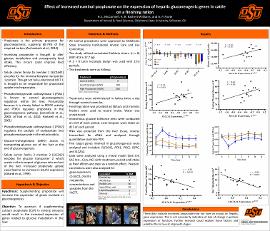| dc.contributor.advisor | Foote, A. P. | |
| dc.contributor.author | McConnell, H. L. | |
| dc.contributor.author | Rathert-Williams, A. R. | |
| dc.date.accessioned | 2022-04-13T14:44:27Z | |
| dc.date.available | 2022-04-13T14:44:27Z | |
| dc.date.issued | 2022-04-19 | |
| dc.identifier | oksd_URS_2022_mcconnell | |
| dc.identifier.citation | McConnell, H. L., Rathert-Williams, A. R., & Foote, A. P. (2022, April 19). Effect of increased ruminal proprionate on the expression of hepatic gluconeogenic genes in cattle on a finishing ration. Poster session presented at the Oklahoma State University Undergraduate Research Symposium, Stillwater, OK. | |
| dc.identifier.uri | https://hdl.handle.net/11244/335219 | |
| dc.description.abstract | The objective of this experiment was to ascertain if supplementing calcium propionate (CaP) in varying amounts would result in the increased expression of genes related to glucose metabolism in the liver. The study utilized cannulated Holstein steers (n = 6) in a replicated 3x3 Latin square with three 15-d periods. The treatments were as follows: Control (no CaP), low propionate (100 g/d CaP), and high propionate (300 g/d CaP). The treatments were administered in halves twice a day through rumen cannulas. The steers were provided with ad libitum finishing ration, using Insentec feeders to record intake, and unrestricted access to water. Liver biopsies were taken on d15 of each treatment and flash-frozen using liquid nitrogen. RNA was extracted from the liver tissue, reverse transcribed for cDNA, and analyzed through quantitative real-time PCR. Five genes were selected as target genes due to their involvement in gluconeogenesis and included solute carrier family 16 member 1 (SLC16A1), phosphoenolpyruvate carboxykinase 1 (PCK1), phosphoenolpyruvate carboxykinase 2 (PCK2), glucose-6-phosphatase (G6PC), and solute carrier family 2 member 2 (SLC2A2). Data were analyzed using a mixed model with treatment, period, and their interaction included as fixed effects and steer as a random effect. There was no treatment effect on hepatic gene expression (P >/= 0.57). SLC16A1 showed a strong, negative, linear relationship with d7 plasma lactate concentration (r = -0.84, P < .0001) and a moderate, negative relationship with fasting plasma lactate concentration (r = -0.55, P = 0.028). SLC2A2 tended to show a moderate, positive, linear relationship with fasting plasma glucose (r = 0.44, P = 0.09), fasting plasma lactate concentration (r = 0.43, P = 0.09), and glucose area under the curve (r = 0.46, P = 0.07). These data indicate that increased propionate may not have an impact on hepatic gene expression. | |
| dc.description.sponsorship | Oklahoma State University. Niblack Research Scholars Program | |
| dc.format | application/pdf | |
| dc.language | en_US | |
| dc.publisher | Oklahoma State University | |
| dc.rights | In the Oklahoma State University Library's institutional repository this paper is made available through the open access principles and the terms of agreement/consent between the author(s) and the publisher. The permission policy on the use, reproduction or distribution of the article falls under fair use for educational, scholarship, and research purposes. Contact Digital Resources and Discovery Services at lib-dls@okstate.edu or 405-744-9161 for further information. | |
| dc.title | Effect of increased ruminal proprionate on the expression of hepatic gluconeogenic genes in cattle on a finishing ration | |
| osu.filename | oksd_URS_2022_mcconnell.pdf | |
| dc.description.department | Animal and Food Sciences | |
| dc.type.genre | Poster | |
| dc.type.material | Text | |
| dc.type.material | Image | |
| dc.subject.keywords | propionate | |
| dc.subject.keywords | cattle | |
| dc.subject.keywords | gene expression | |
| dc.subject.keywords | liver | |
